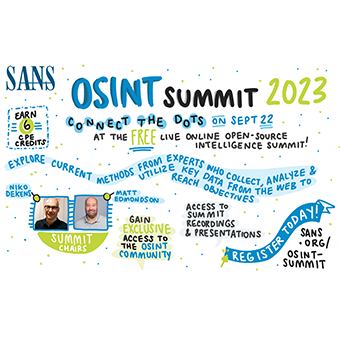What are sock puppets?
Sock puppets, also known as research accounts, are online fictitious identities used to conceal the true identity of the OSINT investigator and to gain access to information that requires an account to access.
Remember, you are responsible for reading and understanding the Terms of Service for the websites you use because creating fake accounts goes against some platforms' Terms of Service; however, this is not usually illegal. It's equally important to check with your organization's policies to ensure you have permission to create and use sock puppets.
Purpose of Sock Puppets
OSINT investigators create sock puppets so they can access content on various sites, such as social media platforms, where content is only available with an account.
Sock puppets are also created to isolate OSINT research, ensuring a separation between the personal and work lives of OSINT investigators. It is essential to emphasize the importance of separating an OSINT investigator's real identity from their research accounts, otherwise known as practicing good Operational Security (OPSEC).
Some platforms, such as Facebook, may tell a target they are being investigated through friend recommendations. Further, suppose you use your personal accounts to conduct OSINT research; you may accidentally "like" a post on your target's profile or accidentally send a friend request.
Posing the following question may help you further understand why it matters that you create sock puppets before researching targets. If you were a police officer, would you conduct surveillance using your personal vehicle? Most of you would hopefully answer "no"; you would not do that. The question to ask yourself is why you would use a personal Facebook account to research your subject. It's similar because your vehicle links to your real identity, just as your social media accounts link back to your real identity.
The Benefits of Sock Puppets
It is recommended that OSINT investigators avoid using their personal social media accounts for research purposes to uphold their privacy and security and ensure the investigation's integrity. Keeping personal and work accounts separate when conducting research is crucial for gathering information discretely and anonymously for good OPSEC.
What are the Sock Puppet Functions?
Most OSINT investigators will conduct passive research. That being said, it's important to understand the difference between passive versus active open-source research and collection because how sock accounts are set up will differ depending on the research type.
Passive means you do not engage with a target. However, your profile might still end up in these results of such things as "suggested friends" or "people to follow," so you may want to blend in a little. Choosing a name that blends into your target group is a good idea.
Active research means engaging with a target in some fashion, i.e., adding the target as a Facebook friend. Blending in with the target group is even more imperative for active research. If you are engaging with a target, you may want to create a couple of accounts on different platforms to make it look like you're a real person.
Best Practices for Sock Puppets
Creating research accounts is not easy, and often, trial and error wins the day.
There is no step-by-step process when setting up accounts, but these are some considerations before creating a research account; some points may seem basic but are equally important.
The best advice is to appear as any regular user who wants to create an account. There are several things to think about. For instance, a typical user would not hesitate when entering their email address and password.
- IP Address - Avoid using a Virtual Private Network (VPN) when creating a sock account, as social media platforms usually flag VPN servers. Once the account is created, using free Wi-Fi connections at locations such as coffee shops to sign into the account is important. The idea is to show the social platform that you are a user who will use your account in multiple locations using different IP addresses in the hope that you don't get flagged.
- Name - Use fictional details when considering a name for your sock account. Avoid using your real identity. Consider what name would blend in with your target group because if you are suggested as a friend, you don't want your account to stand out.
- Email address – You have several email provider options (Mail.com, Gmail.com, Yandex.com, Outlook.com). Do not use a previously created email address – always start fresh and create a new email that has not been previously used.
- Phone verification – If you cannot bypass the phone verification, use a burner phone and SIM card to create accounts.
- Setting/Privacy settings - Immediately review and set the privacy settings for the platform and choose the most secure privacy settings that will allow people to see as little information as possible.
If you're conducting passive research, you may want to keep the account completely locked down and do not need to leave the profile public.
If you're doing active research, you must keep your account locked down until it appears to be that of a real person. Some considerations may include; are there enough Facebook friends, followers, and activity on the profile? Do you have a back story that fits well before you create your profile?
Example: I assisted investigators with setting up a research account that was meant to be used for engaging a subject. I walked them through the process of creating an account. Once the account was up and live, it was important to have a backstory about why this user had a new account. The investigators mentioned that they wanted to keep the friends list open as that would be normal. I quickly noted that this was not a recommended action as it would not fit the backstory of who the investigator was playing. For instance, a male in his early 20s would easily have over 100 friends, so it did not make sense to have an open friends list until it was built up with at least 100 people. - Profile photo - Use generic landscapes like mountains, beaches, etc. Avoid using someone else's identity. Sometimes it is helpful to use stock images and crop the photo so that any previously stored data is deleted before uploading, as social media platforms have algorithms that can detect the use of stock images and flag your account.
- Activity - Once your account is created, it's vital that you start interacting in a natural way, such as posting links, liking pages, etc. The main objective is to mimic how a real person would use a new account and convince the platform that you are a real person.
Learn more about OSITN by taking SEC497 Practical Open-Source Intelligence (OSINT)




.png)
